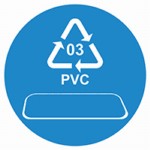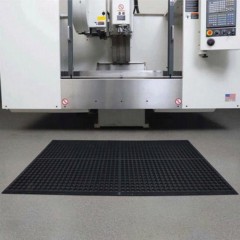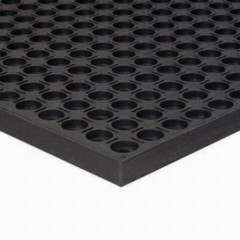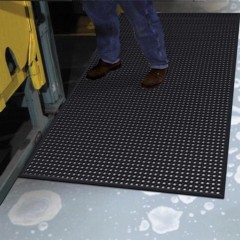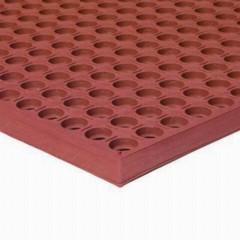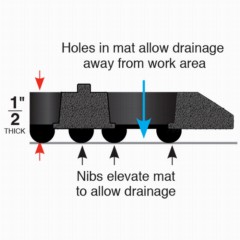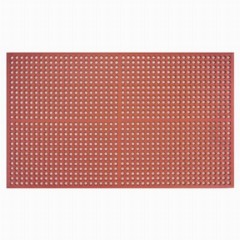Anti Fatigue Rubber Matting
Greatmats has dozens of different designs for its rubber fatigue mats, all of which are perfect for use in a kitchen environment, including industrial, commercial, and residential kitchens.
Size and Shape Options
The majority of rubber fatigue mats will have a rectangular shape. This allows the user to lay the mat horizontally across the front of a counter or food prep space, providing the most potential coverage. Users can move along the length of the mat to reach items without having to leave the mat.
Although sizes like 2x3 and 3x5 feet are the most common, multiple other sizes are available, including lengths of up to 20 feet.
Some of these anti-fatigue mats will include an interlocking edge in a square-shaped mat. This allows the installer to create the precise coverage size desired on the floor. This works especially well in areas where the working space has an odd shape.
Material Options
Rubber is a highly durable material for use in heavy-duty kitchen mats, giving customers a long-lasting style of mat. Because rubber is such a tough material, these floor mats often ship with a multi-year warranty.
In natural rubber mats, customers can find several designs for different coverage sizes and texture options. Having these options ensures customers can find the perfect match.
Some types of rubber use a compound formula that makes them resistant to grease, chemical, and oil spills that may frequently occur in a kitchen environment.
Grease-resistant mats are often red, rather than the traditional black color found in rubber matting, to signify the grease resistance.
We also offer a nitrile rubber (or NBR) style of mat that provides resistance to petroleum-based fluids and mineral oil-based fluids in an industrial environment. NBR makes use of a synthetic rubber compound.
Pattern and Texture Options
Rubber fatigue mats have a naturally grippy surface that delivers non-slip properties. This is especially important in wet environments, like you may find in a kitchen setting, where spills can greatly increase the slip hazard on a hard vinyl or concrete floor.
Many of these mats will have perforations, allowing spilled liquids to drain through the holes to the subfloor.
Some rubber fatigue mats have a flat top surface, while others will have a subtle texture formulated across the top. These textures can be grooves or diamond patterns to enhance traction. A gritty texture is sometimes available, further reducing slip hazards.
Bubble-shaped textures help deliver added anti fatigue properties as well.
To reduce the trip hazard from having a mat in the middle of the kitchen floor, many mats have a beveled edge that creates a ramped edge to eliminate the lip on the mat.
Common Use Options
The top use case for these mats is in a
commercial kitchen setting, where a chef or food preparer must stand for the majority of a shift. The cushioning properties of rubber help people stand more comfortably while working at a counter.
The rubber fatigue mats will also work in an
industrial or factory setting where someone must stand and work for long periods of time. When spills are possible along an assembly line, these mats provide both cushioning and anti-slip properties.
Some people may choose to deploy these mats in a residential setting. It can be more comfortable to stand and prepare a meal or to stand at a craft table or workbench when using these rubber mats. They even work in a laundry room when trying to stack and fold clean clothes or work with wet laundry.
Installation Options
Because rubber has a significant amount of weight, most people can simply lay out these mats without adding any glue or tape. Their weight will hold them in place.
When it’s time to remove them for cleaning or to expose the subfloor again, just pick up the mats and move them to the new location.
To install the interlocking rubber mats, line up a tab on one tile with the loop on the next tile. Pop the tabs and loops together for a tight fit that does not require any glue.
Cleaning and Maintenance Requirements
Because these mats have a design made for use in a kitchen or commercial facility where spills may occur, they can withstand a lot of harsh substances.
If you spill an oil-based or greasy substance on a mat that does not withstand these substances, you should clean up the spill as quickly as possible.
Use a neutral pH-based cleaner diluted with warm water to remove stains and other unwanted substances from the surface of the tile. Allow them to air dry naturally after mopping.
To remove dry debris or solids, run a vacuum cleaner over the top or sweep with a broom.
